Use or create themes in PowerPoint
You can use themes in PowerPoint to simplify the process of creating professional-looking presentations. You can create your own theme containing custom colors, fonts, and effects by starting with a built-in theme and changing its settings. Then you can save the settings as a new theme in your theme gallery.
To learn about the difference between themes and templates in PowerPoint, see Understand the difference between PowerPoint templates and themes.
Overview of Office themes
Theme colors, fonts, and effects work in PowerPoint as well as in Excel, Word, and Outlook, so your presentations, documents, worksheets, and email messages can have a cohesive look. You can find themes in the Themes gallery on the Design tab. To try different themes, rest your pointer over a thumbnail in the Themes gallery and notice how your document changes.
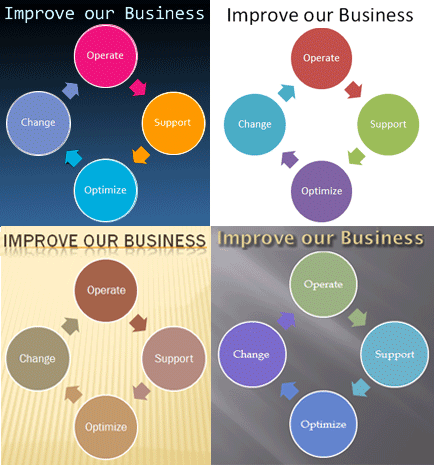
Applying a new theme changes the major details of your document. WordArt effects are applied to titles in PowerPoint. Tables, charts, SmartArt graphics, shapes, and other objects are updated to complement one another. Even the layouts and backgrounds of your slides can be changed dramatically from theme to theme. If you like the way that a theme looks when you apply it to your presentation, you are finished reformatting with just one click. If you want to customize your presentation further, you can change the theme colors, fonts, or effects.
Customizing theme elements
Change theme colors
Theme colors contain four text and background colors, six accent colors, and two hyperlink colors. Under Sample, you can see how the text font styles and colors look before you settle on your color combination.
-
On the View tab, select Slide Master > Colors
 , and then Customize Colors.
, and then Customize Colors.Tip: The colors beneath the Colors button
 represent the theme that is currently applied to your presentation.
represent the theme that is currently applied to your presentation. -
In the Create New Theme Colors dialog box, under Theme colors, do one of the following:
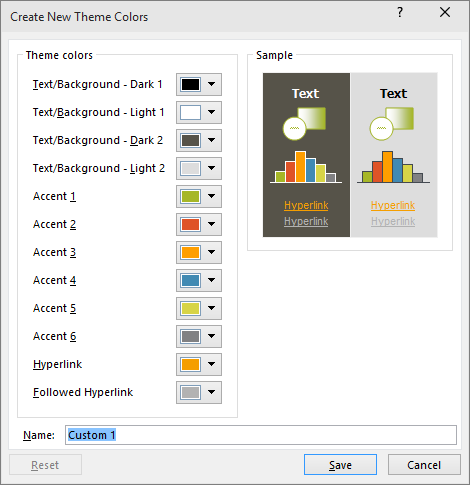
-
Click the button next to the name of the theme color element (for example, Accent 1 or Hyperlink) that you want to change, and then choose a color under Theme Colors.
-or-
Click More Colors, and do one of the following:
-
On the Standard tab, select a color.
-
On the Custom tab, enter a color formula number for the exact color that you want.
Repeat for all of the theme color elements that you want to change.
-
-
In the Name box, type an appropriate name for the new combination of theme colors, and then select Save.
Tip: If you want to return all theme color elements to their original theme colors, select Reset before you select Save.
Change theme fonts
Changing the theme fonts updates all of the title and bullet text in your presentation.
-
On the View tab, select Slide Master. Then on the Slide Master tab, select Fonts
 , and then Customize Fonts.
, and then Customize Fonts. 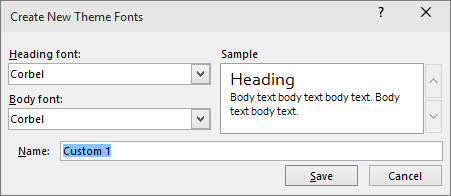
-
In the Create New Theme Fonts dialog box, under the Heading font and Body font boxes, select the fonts that you want to use.
-
In the Name box, type an appropriate name for the new theme fonts, and then select Save.
Choose a set of theme effects
Theme effects include shadows, reflections, lines, fills, and more. While you cannot create your own set of theme effects, you can choose a set of effects that work for your presentation.
-
On the View tab, select Slide Master . Then on the Slide Master tab, select Effects
 .
. -
Select the set of effects that you want to use.
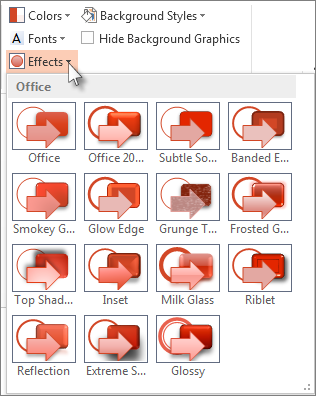
Save a theme
You'll want to save the changes that you make to the colors, fonts, and effects as a theme (.thmx file). That way, you can apply this new theme to your other presentations.
-
On the View tab, select Slide Master. Then on the Slide Master tab, select Themes.
-
Click Save Current Theme.
-
In the File name box, type an appropriate name for the theme, and click Save.
Note: The revised theme is saved as a .thmx file in the Document Themes folder on your local drive, and it's automatically added to the list of custom themes on the Design tab in the Themes group.
Change theme colors
When you click Colors in the Themes group, the colors that you see next to the theme name represent the accent and hyperlink colors for that theme. If you change any of these colors to create your own set of theme colors, the colors that are shown on the Colors button and next to the Theme name will be updated accordingly.
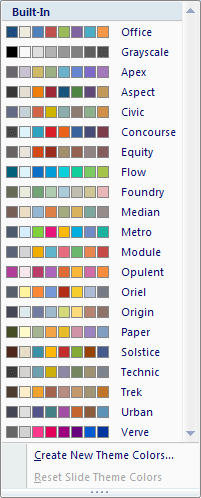
The Theme Colors gallery displays all the color sets from the built-in themes. As shown below, theme colors contain four text and background colors, six accent colors, and two hyperlink colors. Under Sample, you can see how the text font styles and colors look before you settle on your color combination.

-
On the Design tab, in the Themes group, click Colors, and then click Create New Theme Colors.
Tip: The colors inside the Colors button
 represent the theme applied to your presentation.
represent the theme applied to your presentation. -
Under Theme colors, click the button next to the name of the theme color element that you want to change.
-
Under Theme Colors, do one of the following:
-
Click the down arrow of the color that you want to change, and then choose a color from the main list.
-
Click More Colors, and do one of the following:
-
On the Standard tab, select a color.
-
On the Custom tab, enter a recipe for a color that you want.
Repeat steps 2and 3 for all of the theme color elements that you want to change.
Tip: Under Sample, you can see the effect of the changes that you make.
-
-
-
In the Name box, type an appropriate name for the new theme colors, and then click Save.
Tip: If you want to return all theme color elements to their original theme colors, click Reset before you click Save.
Change theme fonts
Every Office theme defines two fonts — one for headings and one for body text. They can be the same font (used everywhere) or two different fonts. PowerPoint uses these fonts to construct automatic text styles. Changing the theme fonts updates all of the title and bullet text in your presentation.
When you click Fonts in the Themes group, the names of the heading font and body text font that are used for each theme font appear below the theme name.
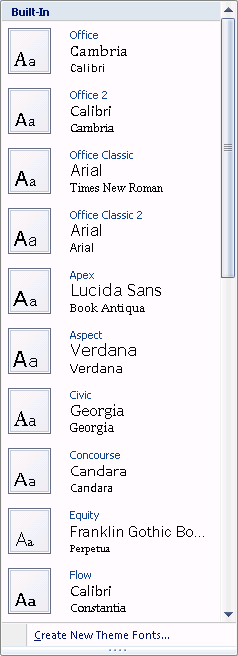
As shown below, you can change the heading and body text fonts of an existing theme to meet the style of your presentation.

Under Sample, you can see samples of the heading and body text styles that you've chosen.
-
On the Design tab, in the Themes group, click Fonts
 , and then click Create New Theme Fonts.
, and then click Create New Theme Fonts. -
In the Heading font and Body font boxes, select the fonts that you want to use.
-
In the Name box, type an appropriate name for the new theme fonts, and then click Save.
Choose a set of theme effects
Theme effects are sets of lines and fill effects. As shown below, you can choose from different groupings of effects to meet the style of your presentation.
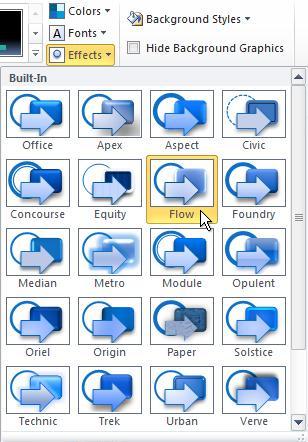
Although you cannot create your own set of theme effects, you can choose the effect that you want to use in your own document or presentation theme.
-
On the Design tab, in the Themes group, click Effects
 .
. -
Click the effect that you want to use.
Save a theme
Save the changes that you make to the colors, fonts, or line and fill effects of an existing theme so that you can apply it to other documents or presentations.
-
On the Design tab, in the Themes group, click More
 .
. -
Click Save Current Theme.
-
In the File name box, type an appropriate name for the theme, and then click Save.
Tip: The revised theme is saved as a .thmx file in the Document Themes folder on your local drive and it is automatically added to the list of custom themes on the Design tab in the Themes group.
See also
Understand the difference between PowerPoint templates and themes
No comments:
Post a Comment